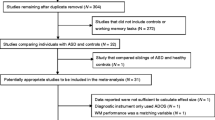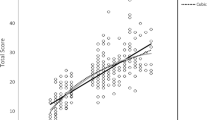Abstract
Previous studies have reported working memory deficits in autism, but this finding has been inconsistent. One possibility is that deficits in this domain may be present only when working memory load exceeds some limited capacity. High-functioning individuals with autism performed the CANTAB computerized test of spatial working memory. Individuals with autism made more errors than a matched group of typically developing controls on this task, and were less likely to consistently use a specific organized search strategy to complete the task. Overall, these results demonstrate reduced spatial working memory abilities in autism, and extend previous findings by demonstrating that these deficits are significant when tasks impose heavier demands on working memory.

Similar content being viewed by others
References
Ameli, R., Courchesne, E., Lincoln, A., Kaufman, A. S., & Grillon, C. (1988). Visual memory processes in high-functioning individuals with autism. Journal of Autism and Developmental Disorders, 18, 601–615.
Baddeley, A. (1986). Working memory: Theory and practice. New York: Oxford University Press.
Bennetto, L., Pennington, B. F., & Rogers, S. J. (1996). Intact and impaired memory functions in autism. Child Development, 67, 1816–1835.
Carlson, S., Martinkauppi, S., Raemae, P., Salli, E., Korvenoja, K., & Aronen, H. J. (1998). Distribution of cortical activation during visuospatial n-back tasks as revealed by functional magnetic resonance imaging. Cerebral Cortex, 8, 743–752.
Diamond, A., Prevor, M. B., Callender, G., & Druin, D. P. (1997). Prefrontal cortex cognitive deficits in children treated early and continuously for PKU. Monographs of the Society for Research in Child Development, 62, 1–208.
Fletcher, P. C., & Henson, R. N. (2001). Frontal lobes and human memory: Insights from functional neuroimaging. Brain, 124, 849–881.
Fuster, J. M. (2000). Prefrontal neurons in networks of executive memory. Brain Research Bulletin, 52, 331–336.
Griffith, E. M., Pennington, B. F., Wehner, E. A., & Rogers, S. J. (1999). Executive functions in young children with autism. Child Development, 70, 817–832.
Goldman-Rakic, P. S. (1988). Topography of cognition: Parallel distributed networks in primate association cortex. Annual Review of Neuroscience, 11, 137–156.
Hollingshead A. B., & Redlich, F. C. (1958). Social class and mental illness. New York: John Wiley & Sons.
Horwitz, B., Rumsey, J. M., Grady, C. L., & Rapoport, S. I. (1988). The cerebral metabolic landscape in autism. Archives of Neurology, 45, 749–755.
Hughes, C., Leboyer, M., & Bouvard, M. (1997). Executive function in parents of children with autism. Psychological Medicine, 27, 209–220.
Hughes, C., & Russell, J. (1993). Autistic children’s difficulty with mental disengagement from an object: Its implications for theories of autism. Developmental Psychology, 29, 498–510.
Hughes, C., Russell, J., & Robbins, T. W. (1994). Evidence for executive dysfunction in autism. Neuropsychologia, 32, 477–492.
Joseph, R. M., Steele, S. D., Meyer, E., & Tager-Flusberg, H. (2005). Self-ordered pointing in children with autism: Failure to use verbal mediation in the service of working memory. Neuropsychologia, 43, 1400–1411.
Koczat, D. L., Rogers, S. J., Pennington, B. F., & Ross, R. G. (2002). Eye movement abnormality suggestive of a spatial working memory deficit is present in parents of autistic probands. Journal of Autism and Developmental Disorders, 32, 513–518.
Le Couteur, A., Rutter, M., Lord, C., Rios, P., Robertson, S., Holdgrafer, M., & McLennan, J. (1989). Autism diagnostic interview: A standardized investigator-based instrument. Journal of Autism and Developmental Disorders, 19, 363–387.
Lord, C., Risi, S., Lambrecht, L., Cook, E. H. Jr., Leventhal, B. L., DiLavore, P. C., et al. (2000). The autism diagnostic observation schedule-generic: A standard measure of social and communication deficits associated with the spectrum of autism. Journal of Autism and Developmental Disorders, 30, 205–223.
Lord, C., Rutter, M., & Couteur, A. L. (1994). Autism diagnostic interview-revised: A revised version of a diagnostic interview for caregivers of individuals with possible pervasive developmental disorders. Journal of Autism and Developmental Disorders, 24, 659–685.
Lord, C., Rutter, M., Goode, S., Heemsbergen, J., Jordan, H., Mawhood, L., & Schopler, E. (1989). Autism diagnostic observation schedule: A standardized observation of communicative and social behavior. Journal of Autism and Developmental Disorders, 19, 185–212.
Luna, B., Minshew, N. J., Garver, K., Lazar, N. A., Thulborn, K. R., Eddy, W. F. et al. (2002). Neocortical system abnormalities in autism: An fMRI study of spatial working memory. Neurology, 59, 834–840.
McCarthy, G., Blamire, A. M., Puce, A., Nobre, A. C., Bloch, G., Hyder, F., et al. (1994). Functional magnetic resonance imaging of human prefrontal cortex activation during a spatial working memory task. Proceedings of the National Academy of Sciences of the United States of America, 91, 8690–8694.
Minshew, N. J., & Goldstein, G. (1993). Is autism an amnesic disorder? Evidence from the California Verbal Learning Test. Neuropsychology, 7, 209–216.
Minshew, N. J., & Goldstein, G. (1998). Autism as a disorder of complex information processing. Mental Retardation and Developmental Disabilities Research Reviews, 4, 129–136.
Minshew, N. J., & Goldstein, G. (2001). The pattern of intact and impaired memory functions in autism. Journal of Child Psychology and Psychiatry and Allied Disciplines, 42, 1095–1101.
Minshew, N. J., Luna, B., & Sweeney, J. A. (1999). Oculomotor evidence for neocortical systems but not cerebellar dysfunction in autism. Neurology, 52, 917–922.
Morris, R. G., Rowe, A., Fox, N., Feigenbaum, J. D., Miotto, E. C., & Howlin, P. (1999). Spatial working memory in Asperger’s syndrome and in patients with focal frontal and temporal lobe lesions. Brain and Cognition, 41, 9–26.
Ohnishi, T., Matsuda, H., Hashimoto, T., Kunihiro, T., Nishikawa, M., Uema, T. et al. (2000). Abnormal regional cerebral blood flow in childhood autism. Brain, 123, 1838–1844.
Owen, A. M., Evans, A. C., & Petrides, M. (1996). Evidence for a two-stage model of spatial working memory processing within the lateral frontal cortex: A positron emission tomography study. Cerebral Cortex, 6, 31–38.
Owen, A. M., Downes, J. J., Sahakian, B. J., Polkey, C. E., & Robbins, T. W. (1990). Planning and spatial working memory following frontal lobe lesions in man. Neuropsychologia, 28, 1021–1034.
Owen, A. M., Morris, R. G., Sahakian, B. J., Polkey, C. E., & Robbins, T. W. (1996). Double dissociations of memory and executive functions in working memory tasks following frontal lobe excisions, temporal lobe excisions or amygdalo-hippocampectomy in man. Brain, 119, 1597–1615.
Ozonoff, S., & Jensen, J. (1999). Brief report: Specific executive function profiles in three neurodevelopmental disorders. Journal of Autism and Developmental Disorders, 29, 171–177.
Ozonoff, S., Pennington, B. F., & Rogers, S. J. (1991). Executive function deficits in high-functioning autistic individuals: Relationship to theory of mind. Journal of Child Psychology and Psychiatry, 32, 1081–1105.
Ozonoff, S., & Strayer, D. L. (2001). Further evidence of intact working memory in autism. Journal of Autism and Developmental Disorders, 31, 257–263.
Papoulis, A. (1990). Probability and statistics. Prentence-Hall International Editions.
Pierrot-Deseilligny, C., Rivaud, S., Gaymard, B., Muri, R., & Vermersch, A. I. (1995). Cortical control of saccades. Annals of Neurology, 37, 557–567.
Robbins, T. W., James, M., Owen, A. M., Sahakian, B. J., McInnes, L., & Rabbitt, P. (1994). Cambridge neuropsychological test automated battery (CANTAB): A factor analytic study of a large sample of normal elderly volunteers. Dementia, 5, 266–281.
Sweeney, J. A., Mintun, M. A., Kwee, S., Wiseman, M. B., Brown, D. L., & Rosenberg, D. R. et al. (1996). Positron emission tomography study of voluntary saccadic eye movements and spatial working memory. Journal of Neurophysiology, 75, 454–468.
Tabachnik, B. G., & Fidell, L. S. (1989). Using multivariate statistics (2nd ed.). New York: Harper and Row.
Zilbovicius, M., Garreau, B., Samsom, Y., Remy, P., Barthelemy, C., & Syrota, A. et al. (1995). Delayed maturation of the frontal cortex in childhood autism. American Journal of Psychiatry, 152, 248–252.
Acknowledgments
Support for the preparation of this manuscript was provided by the National Institute of Child Health and Human Development Collaborative Program of Excellence in Autism (HD35469) and NS33355 & MH01433, and the National Alliance for Autism Research. We are grateful to the families who participated in this research.
Author information
Authors and Affiliations
Corresponding author
Rights and permissions
About this article
Cite this article
Steele, S.D., Minshew, N.J., Luna, B. et al. Spatial Working Memory Deficits in Autism. J Autism Dev Disord 37, 605–612 (2007). https://doi.org/10.1007/s10803-006-0202-2
Published:
Issue Date:
DOI: https://doi.org/10.1007/s10803-006-0202-2




